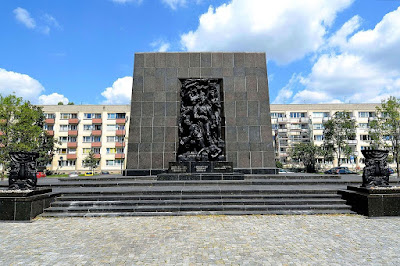 |
| Monument to the Ghetto Heroes by Nathan Rapoport in Warsaw |
Resistance
movements orchestrated by victims during the Holocaust have captured my
interest while studying abroad at the Auschwitz concentration camps in Poland.
While
studying the Holocaust, one is constantly confronted with the fact that the
Nazis were relentless in their pursuit of annihilation of the Jewish people.
The fact that people found the courage and strength to fight back against a
force as powerful as the Nazis fascinates me because hope must have seemed out
of reach for so many people. For the resisters, however, hope was not only
attainable, but sustainable in the form of active opposition.
 |
| Biuletyn Informacyjny - A Polish underground publication during World War II |
In Jewish ghettos during World War II, one way resisters organized was through an underground press. The approximately 1,500 underground publications that appeared in Poland between 1939 and 1945 were in direct opposition to Nazi propaganda. Clandestine publications like the Home Army General Command’s Biuletyn Informacyjny were necessary for providing information untainted by Nazi ideology to the Polish people. As a journalism major at Iona College, I am conscious of the significance of the dissemination of information from various perspectives in maintaining a free society. Of course, German-occupied Poland was never free, but the existence of an underground press was a key factor in the ability of Poles to resist.
 |
| Underground education in Poland - Łopiennik Górny 1941 |
Another
form of resistance that existed during the German occupation of Poland was an
underground schooling system. In spite of German efforts to destroy the Polish intelligentsia
and minimize the education of Poles, clandestine schooling appeared at every
level of education, involving about a million people. This helped shape and
maintain a high level of national consciousness so that Nazi ideology could
never take complete hold of the nation.
 |
| Photo taken during Warsaw Uprising - From Jürgen Stroop's report to Heinrich Himmler - May 1943 |
The
Warsaw Uprising was an act of resistance that stands out as one of the key events
in the history of Polish Jewish resistance against Nazism. According to the
Auschwitz I exhibit “The Struggle and Martyrdom of the Polish Nation 1939-1945,”
the Jewish National Committee rallied the Jews of the Warsaw Ghetto to revolt. Alexander
Donat’s memoir, The Holocaust Kingdom,
detailed the author’s experience of the uprising, which broke out on April 19,
1943.
“The
entire length of Niska Street was one billowing sheet of smoke and flame,”
Donat writes. “The fighters put up a fierce defense and our own building had
joined in the shooting. We all were suffering from lack of sleep and food, but
we were at high tension, gripped by a kind of ecstasy that made any effort seem
within our capabilities” (p. 155).
 |
| SS men strolling past a burning building during the Warsaw Uprising |
Despite
the passion of the Jews, the uprising was crushed after 63 days. The revolt was
carried out with almost no assistance from the western Allies. To this day, the
Warsaw Uprising is representative of the fighting spirit that Jews held onto
even in the face of crushing opposition.
The
resistance efforts carried out by Polish Jews during the Second World War
deserve recognition as outstanding models of human perseverance. The examples
in this blog post are only a few of the many ways Polish Jews fought to
maintain their dignity as human beings.
By Michael Coppola












0 comments:
Post a Comment